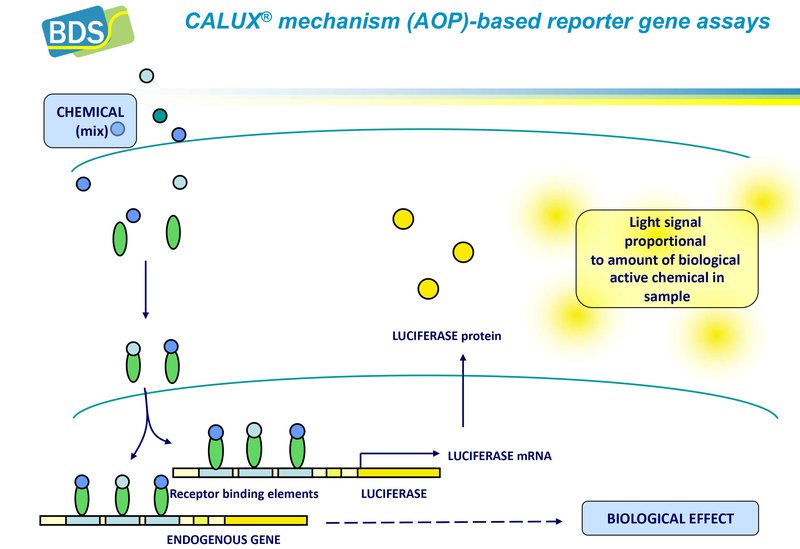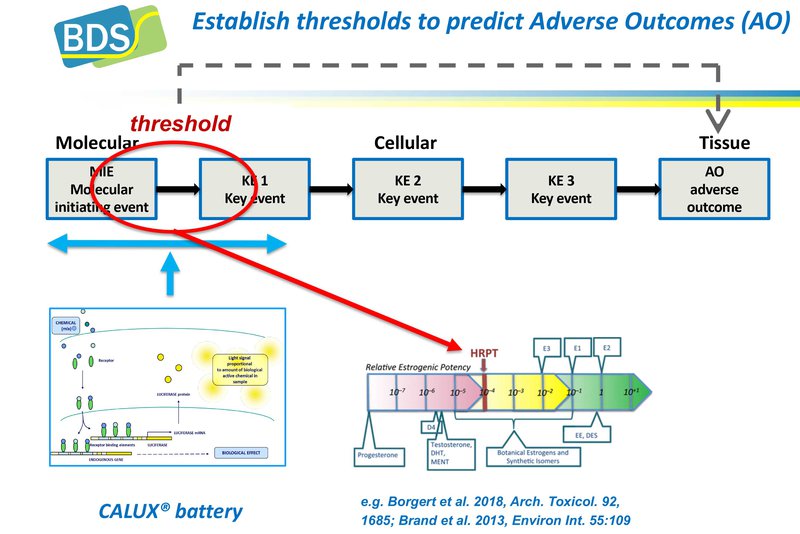Endocrine Disruption
- About
- Our solutions for you
- Our services
- Partner contribution
- CALUX® methods
- Regulatory Framework
- Request further information
- Order Links
About

With our package we provide a solution to characterize your ingredients with integrated approaches in concern of their effect on the endocrine system following the EFSA and OECD guidelines. This includes platforms for in silico modeling as well as next-generation in vitro and in vivo assays based on cutting-edge research findings to identify new key events. Those datasets are implemented and integrated into the assessment process to offer improved predictions of potential endocrine risks of your ingredients.
Our services
With our packages, we contribute to the early stage (Level 1) risk assessment of chemicals for endocrine disruption by:
- Integrating data on physical and chemical properties such as molecular weight, reactivity, volatility, biodegradability, etc.
- Integrating (eco)toxicological data from standardized or non-standardized tests.
- Integrated in silico approaches where we apply machine learning algorithms to evaluate compounds based on ontologies and feature extraction of compounds in a large set of databases.
Partner Contribution
In addition to our contribution, our partners complete a comprehensive and holistic understanding of your compound by means of in vitro and in vivo assays as well as further in silico approaches:
Kreatis (Level 1)
Keratis offers QSAR data modeling which can be accessed by iSafeRat. iSafeRat is a user-friendly platform where you can run MechoA scheme models, predict mechanisms of toxic action of substances in various species and design safe chemicals (eco conception).
> Read more
IRFMN (Level 1)
The Instituto di Ricerche Pharmacologiche Mario Negri (IRFMN) provides expertise in computational predictive toxicology based on QSAR implementation. IRFMN puts great emphasis on ensuring that its models generate transparent, understandable, reproducible, and verifiable results.
> Read more
BioDetection Systems (Level 2)
BioDetection provides next-generation solutions by effect-based analyses (CALUX luciferase assays) and target-based assays to measure the bioactivity of chemicals.
> Read more
Biobide (Level 3)
Biobide has the expertise to run a wide range of zebrafish assays to characterize compounds and their impact on organismic development.
> Read more
CALUX® methods
Endocrine disruption has been recognized as a priority endpoint in safety evaluation of chemicals and consumer products. Endocrine disrupting compounds (EDCs) are being classified as substances of very high concern and regulations to restrict their use are being installed world-wide. EDC effects are hard to predict and are best tested using bioassays. To avoid animal studies BDS has developed a range of assays that allow screening and safety assessment of chemicals and complex mixtures including consumer products in a rapid and cost-effective manner.
CALUX® methods available for endocrine disruption screening
The unique CALUX® - based test panel includes
- Assessment of interferences with estrogen-, androgen- and thyroid pathways and steroidogenesis (EATS) using robust and quantitative human CALUX® reporter gene technology (1), and complementary assays
- Methods to measure in a wide variety of products and applications
- Used world-wide in major chemical-, pharmaceutical-, cosmetics-, food- and feed companies, and others
- Extensively validated to demonstrate robustness and predictivity
- Contract service or transferred to your laboratory via licensing and training
The high throughput screens are particularly suited for safe design, and in a regulatory context endocrine disruption. All methods can be combined with appropriate metabolic fractions (2).
Standard analyses performed according to OECD guidelines (for EA and S; under development for T), under ISO17025 and GMP+ certified conditions.
BDS’ assays are extensively validated, strictly quality controlled and link to a range of internationally accepted guidelines (OECD, ISO, EU). Being specific mechanism-based assays, the analytical results are straightforward and relatively easy to interpret. This is particularly the case for the endocrine assays, where linkage to reference methods is straightforward (3). In many cases this has allowed the definition of thresholds that can be used as points-of-departure in risk analysis.
Description of Assays
BDS develops and applies CALUX® mechanism-based high throughput screening panels for all major toxicity classes in REACH. In particular, the test battery for endocrine disruption is now able to comprehensively measure all endpoints of prime regulatory concern (as described in the ECHA/EFSA guidance document), i.e. androgen-, estrogen-, thyroid-, and steroidogenesis (EATS) effects, with- or without metabolic activation. All modules are linked to OECD guidelines or are subject to evaluation. The thyroid module includes receptor activation, ligand conversion and transport. Recently, the AR CALUX has been validated favourably by ECVAM and was included in OECD TG458. The battery of CALUX tests has been extensively used in a range of read-across case studies, including those aiming at regulatory application or in a safe design context (4-7). The CALUX methods have additionally been transformed from the classical manual format to high throughput format (384 wells) using robotics. Comprehensive panels of bioassays have been developed for safety- and activity profiling.
EATS Endocrine Disruption Panel
- E: (anti) Estrogens: ERalpha CALUX (OECD TG 455)
- A: (anti) Androgens: AR CALUX (ECVAM validation, OECD TG 458)
- T: Thyroid interference: TRbeta CALUX, TTR and TOP assay (TG in preparation)
- S: H295R steroidogenesis (OECD 456)
- Phase 1 and Phase 2 metabolic steps
Approach
Based on its CALUX reporter gene technology and focusing on the EATS mode of action of EDCs BDS has developed a range of specific assays that allow screening and safety assessment of chemicals and consumer products in a rapid and cost-effective manner. Complementary assays have been selected to complete the comprehensive panel.

These assays have been extensively validated and most of them already incorporated in relevant OECD test guidelines. These OECD guidelines define thresholds based on the threshold between negative and positive compounds. In addition thresholds have been defined for specific applications such as water quality monitoring, thereby assessing the effects of complex mixtures. In addition, methods have been used for safe design of new chemical entities. Methods can be used with and without modular metabolic systems.

In Silico Evaluation and Reporting
An initial compound evaluation based on existing data and models is available as a report service. The analysis follows EcHA guidance on the analysis of existing data and models and recommendations for in vitro testing following OECD guidance. When desired by the customer, detailed harmonized datasets and analysis can be provided with testing result reporting.
Regulatory Guidance
A regulatory guidance service is provided supporting the preparation of reporting information for regulatory purposes (e.g., REACH reporting).
VISIT OUR SHOP
> Request an Assay from BioDetection Systems
References
- Van der Burg, B., Van der Linden, S.C., Man, H.Y., Winter, R., Jonker, L., Van Vugt-Lussenburg, B., Brouwer, A. (2013) A panel of quantitative CALUX® reporter gene assays for reliable high throughput toxicity screening of chemicals and complex mixtures. In "High throughput screening methods in toxicity testing" (P. Steinberg, ed). John Wiley and Sons, Inc. New York. ISBN 9781118065631
- van Vugt-Lussenburg, B.M.A., van der Lee, R.B., Man, H.Y., Middelhof, I., Brouwer, A., Besselink, H., van der Burg, B. (2018) Incorporation of metabolic enzymes to improve predictivity of reporter gene assay results for estrogenic and anti-androgenic activity. Reprod. Toxicol. 75:40-48.
- Van der Burg, B., Van der Linden, S.C., Man, H.Y., Winter, R., Jonker, L., Van Vugt-Lussenburg, B., Brouwer, A. (2013) A panel of quantitative CALUX® reporter gene assays for reliable high throughput toxicity screening of chemicals and complex mixtures. In "High throughput screening methods in toxicity testing" (P. Steinberg, ed). John Wiley and Sons, Inc. New York. ISBN 9781118065631
- Van der Burg, B., Van der Linden, S.C., Man, H.Y., Winter, R., Jonker, L., Van Vugt-Lussenburg, B., Brouwer, A. (2013) A panel of quantitative CALUX® reporter gene assays for reliable high throughput toxicity screening of chemicals and complex mixtures. In "High throughput screening methods in toxicity testing" (P. Steinberg, ed). John Wiley and Sons, Inc. New York. ISBN 9781118065631
- van Vugt-Lussenburg, B.M.A., van der Lee, R.B., Man, H.Y., Middelhof, I., Brouwer, A., Besselink, H., van der Burg, B. (2018) Incorporation of metabolic enzymes to improve predictivity of reporter gene assay results for estrogenic and anti-androgenic activity. Reprod. Toxicol. 75:40-48.
- Sonneveld, E., Riteco, J.A.C., Jansen, H.J., Pieterse, B., Brouwer, A., Schoonen, W.G., Van der Burg, B. (2006) Comparison of in vitro and in vivo screening models for androgenic and estrogenic activities. Toxicol. Sci., 89,173-87.
- Van Vugt-Lussenburg B, Van Es D, Naderman M, le Notre J, van der Klis F, Brouwer A, Van der Burg B. (2020) Endocrine activities of phthalate alternatives; assessing the safety profile of furan dicarboxylic acid esters using a panel of human cell based reporter gene assays. Green Chemistry 22, 1873-1883
Regulatory Framework
To guarantee the safety and reliability of our characterization models, scientific integrity has highest priority which not only underlies the current guidelines on endocrine disruption risk assessment but which also takes into account what upcoming regulatory guidelines might include based on the current concepts:
- EFSA Guidance for the identification of endocrine disruptors in the context of Regulations (EU) No 528/2012 and (EC) No 1107/2009
- OECD Revised Guidance Document 150 on Standardized Test Guidelines for Evaluating Chemicals for Endocrine Disruption
Reference:BDS-TCP
Vendor:BioDetection Systems BV (BDS)
Reference:IRFMN-Vega
Vendor:IRFMN - Istituto di Ricerche Farmacologiche Mario Negri
Product: VEGA models
Endocrine disruptors are found in many products of everyday life such as plastics (Bisphenol A), herbicides and paper (Dioxins), pharmaceuticals, fireworks, and drinking water (Perchlorate), firefighting foams and textiles (Perfluoroalkyls and Polyfluoroalkyls), Cosmetics (Phtalats), Plant-based products such as tofu (Phytoestrogens), flame retardants and furniture foams (polychlorinated diphenyl ethers), transformers (Polychlorinated biphenyls) and personal care products (Triclosan), to name only a few. They affect and disrupt normal endocrine function leading to an imbalanced hormone household. Already small changes in hormone concentration can have a fatal impact on organisms, leading to severe diseases, such as neurodegenerative diseases. Therefore, assessing the risk of known and new compounds, especially when it comes to nanomaterials, is key to producing safe and green products to ensure health for all of us.